Comets discovered in December 2015
P/2015X1 PANSTARRS
Eva Lilly, Robert Weryk, and Richard Wainscoat report the discovery of an apparent comet on four CCD frames taken on Dec. 1.3 UT with the 1.8-m Pan-STARRS1 telescope on Haleakala(CBET4212).
After the comet was posted on the Minor Planet Center's PCCP webpage, other CCD astrometrists also noted the object's cometary appearance. Later were found pre-discovery images from the PANSTARRS1 telescope between August to October 2015 so a elliptical orbital elements were made by G.V. Williams.
Orbital elements from 55 observations 2015 Aug. 12-Dec. 8 (MPEC 2015-X58):
T 2015 Oct. 10.67128
q 2.1035529
n 0.14254612
a 3.6293800
Peri. 219.02793
Node 161.79123
Incl. 12.16227
e 0.4204099
P 6.91
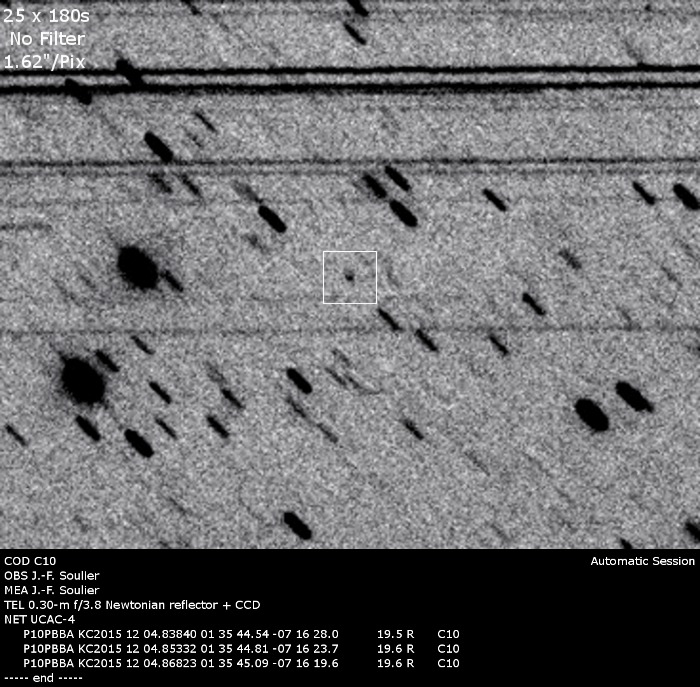
©Jean-Francois Soulier
C/2015X2 Catalina
An apparently asteroidal object reported to the Minor Planet Center on CCD images taken by Erik. J. Christensen and G. J. Leonard with the Catalina 0.68-m Schmidt telescope on December 21.42UT (CBET4213). The object has been found to show cometary appearance by CCD astrometrists like G. Hug (Scranton, KS, U.S.A.) writes that his CCD images taken on Dec. 3.4 UT with a 0.56-m reflector show a possible short, bright tail extending for about 10"-15" in p.a. 285 deg, while additional images taken by J.-F. Soulier with a 0.30-m f/3.8 Newtonian show a 12" coma and a possible tail 21" long in p.a. 295 deg; he measured red mag 19.4-19.6 in a 9".7-radius aperture.
The following preliminary parabolic orbital elements by G. V. Williams, and an ephemeris appear on MPEC 2015-X59.
From 36 observations 2015 Dec. 2-8:
T 2015 Dec. 20.67512
q 1.9047133
n 0.01567709
a 15.8109915
Peri. 41.99887
Node 101.09172
Incl. 72.45310
e 0.8795323
P 62.9
The MPC elements suggest that the comet is near perihelion at 1.9 au at the moment of the discovery
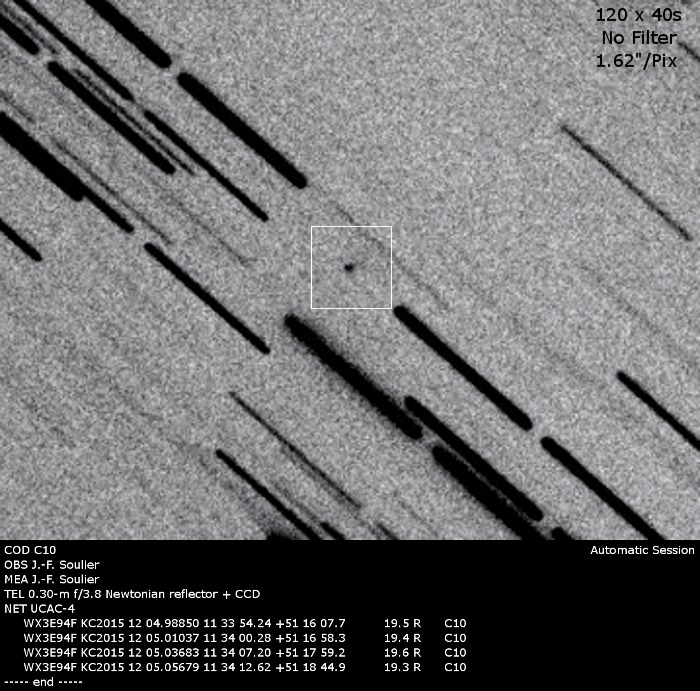
©Jean-Francois Soulier
P/2015X3 PANSTARRS
R. J. Wainscoat reports that an object found on four r-band exposures obtained on Dec. 1.4 UT with the 1.8-m Pan-STARRS1 telescope on Haleakala(CBET4215). Later were found pre-discovery images from the PANSTARRS1 telescope on November 2015. After the comet was posted on the Minor Planet Center's PCCP webpage, other CCD astrometrists also noted the object's cometary appearance like H. Sato(Tokyo, Japan) writes that the comet shows to be strongly condensed with a coma 6" in diameter and no tail
The available astrometry, the following elliptical orbital elements by G. V. Williams, and an ephemeris appear on MPEC 2015-X104:
T 2015 Aug. 7.80510
q 2.8224273
n 0.08750112
a 5.0248946
Peri. 306.88909
Node 77.32904
Incl. 24.37688
e 0.4383111
P 11.3
From 31 observations 2015 Nov. 6-Dec. 10.
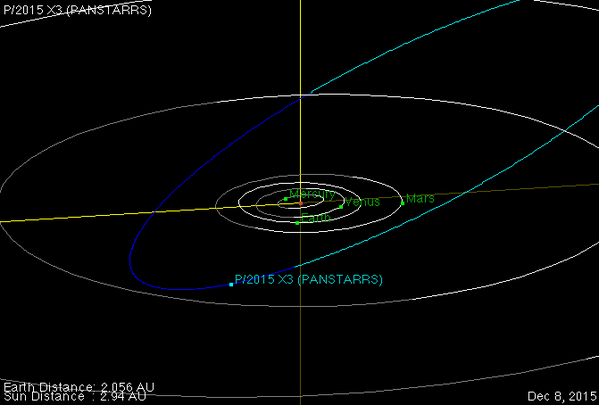
C/2015X4 Elenin
Leonid Elenin(RUS) reports his discovery of a diffuse comet with slight condensation on three CCD images taken with a 0.4-m f/3 astrograph at the ISON-NM observatory near Mayhill, NM, USA, on Dec. 3.5 (CBET4216). He noted a coma with diameter about 12" and a 15" tail in p.a. 280 deg.
After the comet was posted on the Minor Planet Center's PCCP webpage, other CCD astrometrists also noted the object's cometary appearance. Images obtained by C. Jacques, E. Pimentel, and J. Barros on Dec. 3.7 UT
with an iTelescope 0.51-m f/4.5 reflector at Siding Spring show a condensed coma 5" in diameter, elongated 8" towards p.a. 145 deg. E. Guido, Castellammare di Stabia, Italy, writes that twenty stacked 120-s unfiltered exposures, obtained remotely with an iTelescope 0.32-m f/8 astrograph near Nerpio, Spain, on Dec. 3.9, show a compact coma nearly 8" in diameter (with red mag 17.1-17.2), elongated toward p.a. 120 deg.
E. Bryssinck, Kruibeke, Belgium, relates that four stacked 120-s images obtained on Dec. 4.9 with a 0.4-m f/3.8 astrograph shows a condensed circular coma 12" across. More other comet astrometrists contribute to confirm this new comet so a complete orbit with more than 200 observations were computed by G.V. Williams and then posted on MPEC 2015-X105.
T 2015 Nov. 4.14888
q 3.4008343
n 0.01263602
a 18.2555849
Peri. 176.48226
Node 262.65238
Incl. 29.59536
e 0.8137099
P 78.0
Sometimes Amateur people can beat the automatic Telescope around the world, this is the 5th comet discovered by Elenin.
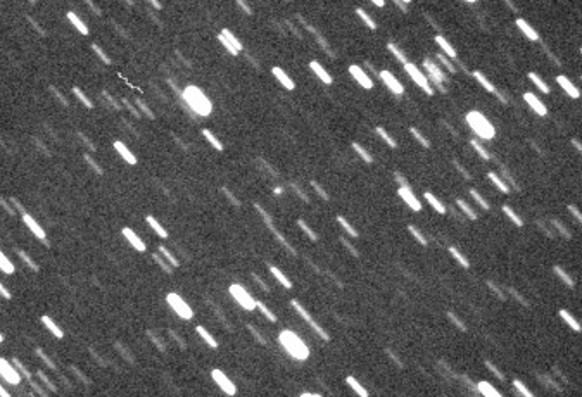
©Andrea Mantero
C/2015 X5 PANSTARRS
R. Weryk, Institute for Astronomy, University of Hawaii, together with E. Lilly and R. J. Wainscoat, report the discovery of another comet in four r-band exposures taken with the 1.8-m Pan-STARRS1 telescope on Haleakala on December 6.55(CBET4220).
The object described as having an extended profile. After the object was posted on the Minor Planet Center's NEOCP and PCCP webpages, other CCD astrometrists also noted the object's cometary appearance. The available astrometry(From 22 observations 2015 Dec. 6-15), the following preliminary parabolic orbital elements by G. V. Williams, and an ephemeris appear on MPEC 2015-X179:
T 2013 Sept. 8.28556
q 3.8956634
Peri. 250.43571
Node 127.88134
Incl. 110.84447
e 1.0
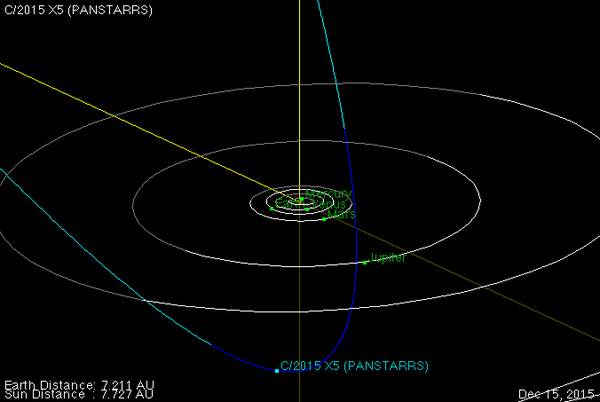
P/2015X6 PANSTARRS
E. Lilly and R. Weryk report the discovery of another comet in three w-band exposures taken with the 1.8-m Pan-STARRS1 telescope on Haleakala on December 7.27(CBET4221).
After the object was posted on the Minor Planet Center's NEOCP and PCCP webpages, other CCD astrometrists also noted the object's cometary appearance.
V-band images taken by W. H. Ryan and E. V. Ryan with the Magdalena Ridge Observatory 2.4-m f/8.9 reflector on Dec. 8.24-8.26 UT show a short, thin, prominent tail at p.a. about 70 deg.
The available astrometry(From 30 observations 2015 Dec. 7-17), the following elliptical orbital elements by G. V. Williams, and an ephemeris appear on MPEC 2015-X180.
T 2016 Mar. 10.50832
q 2.3009867
n 0.21868786
a 2.7284726
Peri. 326.19340
Node 107.12569
Incl. 4.55980
e 0.1566759
P 4.51
C/2015X7 ATLAS
Larry Denneau, on behalf of the "Asteroid Terrestrial-impact Last Alert System" (ATLAS) Team, reports the discovery of a slightly diffuse comet with the new ATLAS 0.5-m f/2.0 Schmidt telescope at Haleakala from nine CCD exposures taken on Dec. 12 and 13 (CBET4223). The ATLAS Team obtained confirming images on Dec. 17 that show the comet to have a small coma with a short tail at p.a. 30 deg and a longer, fainter tail extending for about 1' in p.a. approximately 110 deg. After the object was posted on the Minor Planet Center's NEOCP and PCCP webpages, L. Buzzi (Varese, Italy) writes that his stacked CCD exposures taken on Dec. 17.04-17.05 UT with a 0.60-m f/4.6 reflector at low altitude (15 deg above his southern horizon) shows a condensed coma 10" in size with no clear tail visible in the crowded star field; he measured red magnitude 18.0.The available astrometry (35 observations spanning Dec. 12-19), the following preliminary parabolic orbital elements by G. V. Williams, and an ephemeris appear on MPEC 2015-Y18.
T 2016 Aug. 3.50357
q 3.7517100
Peri. 348.30929
Node 139.56372
Incl. 58.01661
e 1.0
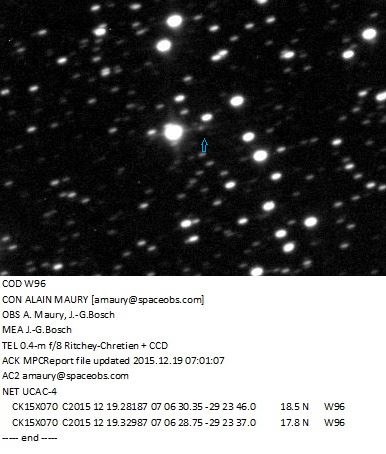
©Jean-Gabriel Bosch
C/2015X8 NEOWISE
On Dec. 18, J. Bauer reported to the Minor Planet Center astrometry measured from images of an unknown extended object that was found on infrared images taken with the Near-Earth Object Wide-field Infrared Survey Explorer(CBET 4225). After the object was posted on the Minor Planet Center's PCCP webpage, several ground-based CCD astrometrists have confirmed the cometary appearance below listed:
-H. Sato, Tokyo, Japan, writes that the object to be strongly condensed with a round outer coma 25" in diameter and no tail; the w-band magnitude was 15.9 as measured within a circular aperture of radius 12".6. -C. Jacques, E. Pimentel, and J. Barros on Dec. 18.5 writes that the comet show a strong central condensation 51" in diameter surrounded by a diffuse coma that was measured to be 2'11" in diameter, with r-mag.17.2.
-A. Hale, Cloudcroft, NM, USA, reports that he followed the comet visually for about an hour with a 0.41-m reflector; he notes that the comet was very vague and diffuse with just the very slightest central brightening and without condensation, and he measured total visual magnitude 12.8 with coma diameter 2'.4 on Dec. 18.49.
The available astrometry (spanning Dec. 14-18), the following preliminary parabolic orbital elements by G. V. Williams, and an ephemeris appear on MPEC 2015-Y20.
T 2015 Oct. 26.58759
q 1.2223806
Peri. 23.87267
Node 191.31266
Incl. 155.10831
e 1.0083804
The comet is visible in winter in Northern Sky while fading rapidly and appear very diffuse.
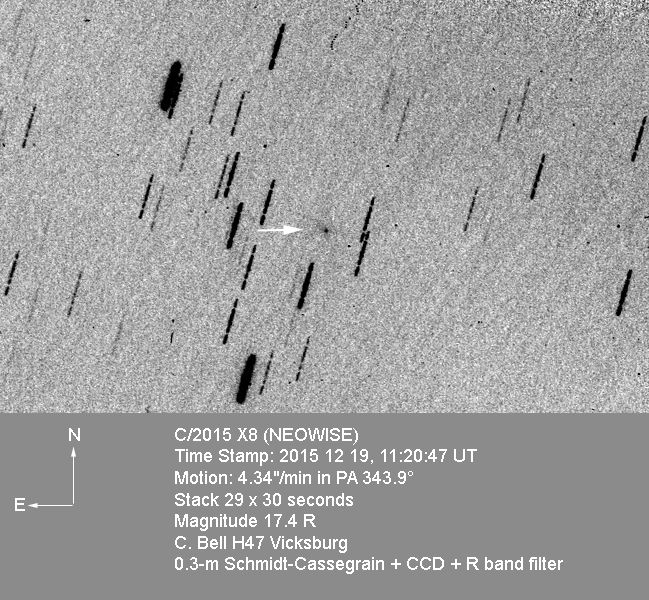
©Charles Bell
C/2015 XY1 LEMMON
An apparently asteroidal object discovered on CCD images obtained by J. A. Johnson with the Mount Lemmon 1.5-m reflector on Dec. 4.51 was given the minor-planet designation 2015 XY_1 when published on MPS 657469. Numerous 30-s Mt. Lemmon Survey images taken subsequently by E. J. Christensen on Dec. 16.45-16.47 UT show the object (identified by Christensen with 2015 XY_1 apparently after finding it as a potential new discovery) with a coma of size about 8" and magnitude 19.7-20.0(CBET4222).
The available astrometry (spanning Dec. 4-16), the following preliminary parabolic orbital elements by G. V. Williams, and an ephemeris appear on MPEC 2015-Y06. With only 18 observations the orbital elements are still uncertain.
T 2018 Mar. 30.39460
q 8.1401464
Peri. 193.26901
Node 281.33831
Incl. 149.07488
e 1.0
C/2015 Y1 LINEAR
An apparently asteroidal object found on CCD images taken on Dec. 16 in the course of the LINEAR survey has been found to show cometary appearance by CCD astrometrists elsewhere after the object was posted on the Minor Planet Center's NEOCP and PCCP webpages (CBET4227).
Most astrometrists, like A. Maury, J-F Soulier and H. Sato in several images between Dec. 18-19 a strongly condensed coma and 20-30” tail. The available astrometry (spanning from 64 observations Dec. 16-20), the following preliminary parabolic orbital elements by G. V. Williams, and an ephemeris appear on MPEC 2015-Y58.
T 2016 May 15.93496
q 2.5019994
Peri. 25.24373
Node 135.72592
Incl. 71.33792
e 1.0
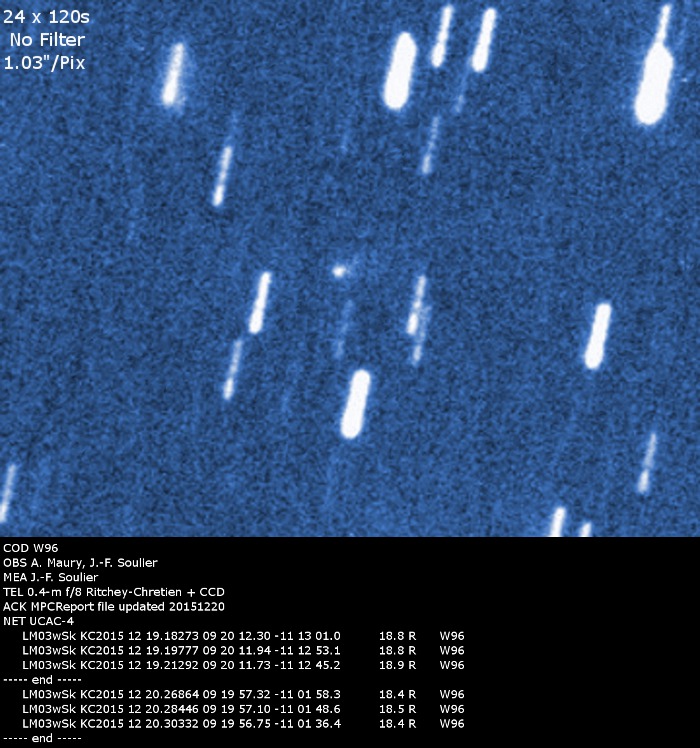
©Jean-Francois Soulier
C/2015 YG1 NEOWISE
J. M. Bauer, Jet Propulsion Laboratory, forwards a report by S. Sonnett of another comet found on infrared images taken with the Near-Earth Object Wide-field Infrared Survey Explorer(NEOWISE). The Minor Planet Center assigned the minor-planet designation 2015 YG1 on MPEC 2015-Y48 before it received word from the NEOWISE team that the object appeared cometary(CBET4228).
After the object was posted on the Minor Planet Center's NEOCP webpage, ground-based CCD astrometrists noted the cometary appearance.
M. Schwartz writes that three exposures taken with the 0.81-m Tenagra II telescope (Nogales, AZ, U.S.A.) between Dec. 19.51 and 19.54 showed a coma of diameter 10" and a broad tail with length about 20" toward p.a. 330 degrees. The available astrometry (spanning Dec. 17-19), the following T 2015 Oct. 1.82057 preliminary parabolic orbital elements by G. V. Williams, and an ephemeris appear on MPEC 2015-Y59
T 2015 Oct. 1.82057
Peri. 105.53961
Node 351.41240
Incl. 58.28831
q 2.1932464
e 1.0
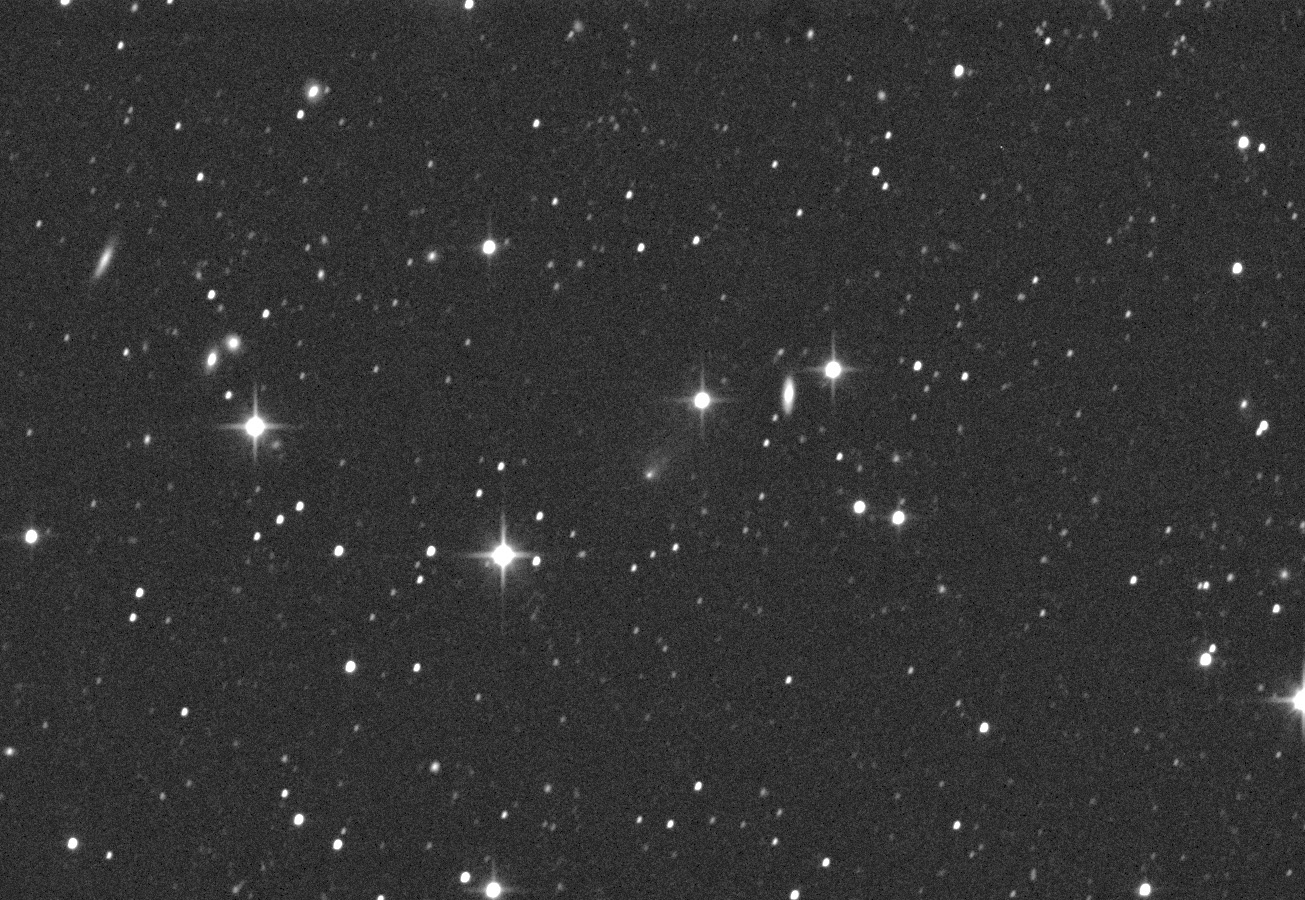
©Michael Jager
